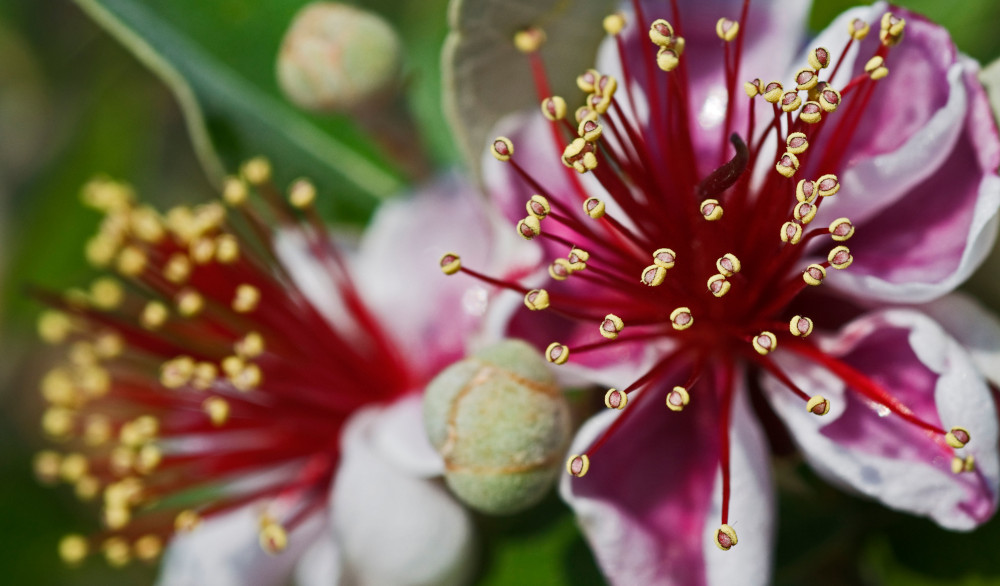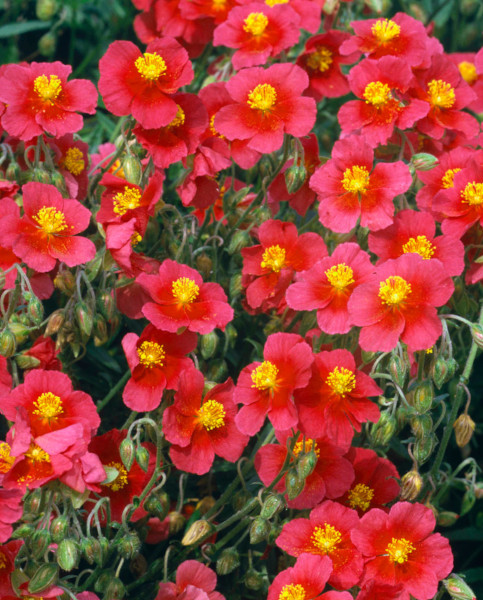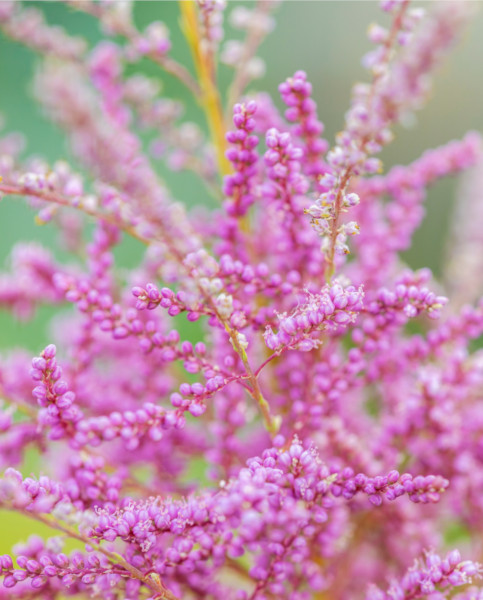How to grow Acca
Acca is a genus of three species of evergreen shrubs in the myrtle family. Originating from the highlands of South America, they tend to be hardy to around -5°c and are one of the most exotic-looking flowers able to grow in our UK climate.
The species offered by Hayloft is the most notable within the genus; Acca sellowiana, also known as Pineapple Guava or Feijoa. As the first common name suggests, this is a plant widely grown for its fruit; zingy in flavour with minty tones, often hailed by its admirers as one of the tastiest fruits in the world. A. sellowiana is popular throughout the Mediterranean, Australia, and Southern Russia and is especially prized in New Zealand where the fruit features heavily in traditional recipes and dishes.
In the UK, fruiting is most likely to occur when grown under cover in a conservatory or greenhouse. Outdoor growing is possible, though for the interesting foliage and flowers rather than fruit. Oblong, evergreen, grey-green leaves are tactile and inviting, with dense, white, furry felting on the underside. Over summer there is a succession of beautiful pink-white flowers with red fluffy stamens bursting out of them like fireworks. A striking and unusual addition to any garden.

Key Information
Soil pH
Position
Hardiness


Where & when to plant Acca
OUTDOORS:
For best results, plant in autumn or spring. An autumn planting is suitable for those gardening in ‘mild’ conditions. (Broadly speaking, this is the southern half of the UK). For those liable to very cold winters or waterlogged ground, it is best to wait until spring. (This is generally the northern half of the UK, or anyone gardening on heavy, clay soil).
Planting can be done at other times throughout the year, providing a watchful approach to watering is taken until plants are established.
Sellowiana enjoy a well-drained soil and are even tolerant of drought conditions. The more sheltered the spot, the better, with as much sun as possible to give the plant maximum benefit. This special plant will even tolerate salty conditions, making it an ideal choice for coastal gardens.
INDOORS:
Spring is the best time of year to pot up permanently container grown plants. Ensure that your container is located in full light and bear in mind plants can be moved outdoors during the warmer months if desired – they will benefit from pollinators and the circulation of air this provides.
How to plant Acca
OUTDOORS:
- Select your location, bearing in mind this evergreen shrub will reach a height of 3m and a spread of 1.5m when grown freely
- Clear the area of weeds
- Dig a hole the same depth as the root ball and twice as wide
- Place the plant in the hole
- Backfill with soil and gently firm in with foot
- Soak well with water
- Mulch around the base with well-rotted organic matter
INDOORS:
- Choose an appropriate container – large enough to hold the root ball with additional space to grow. Ensure there are plenty of drainage holes in the bottom
- Use a loam-based potting compost, mixing in a few handfuls of horticultural grit to aid drainage
- Start with a layer of compost in the bottom of the pot, deep enough so that when placed on it, the root ball sits about an inch beneath the top of the pot
- Fill all space surrounding the root ball with compost, using fingers to firm in, avoiding looseness
- Place on plant saucer if required
- Soak well with water
- A mulch with horticultural grit will look attractive and help to prevent a ‘cap’ or crust forming on the top of the compost (something which can happen to container plants as a result of watering)

What to plant with Acca
Sellowiana will look good as a standalone specimen in a city or courtyard garden. It also lends itself well to a Mediterranean planting scheme, having similar growing requirements to plants such as cistus and helianthemum. Alternatively, its suitability for coastal gardens makes this acca an excellent companion to the similarly salt-loving tamarix.
Indoors, it looks wonderful when grouped with tibouchina and citrus.
If you would like any further planting ideas or growing advice for your acca, please contact our friendly and knowledgeable Customer Care Team - we will be more than happy to help you.



How to care for Acca
Pruning and Deadheading
No pruning is necessary, though if required (to maintain a certain size or shape, or clear out untidy dead wood) this is best done in spring.
Watering
OUTDOORS:
Water well until fully established, after which this drought tolerant plant is unlikely to require any irrigation.
INDOORS:
Water freely in the growing season, more sparingly during winter. Apply a liquid fertiliser every four weeks during the growing season.
Cold Protection
May require frost protection if temperatures consistently reach beneath -5°c.
Pests and Diseases
This plant tends to be trouble free.
How to propagate Acca
Find non-flowering shoots of the current year’s growth, soft at the tip and woody at the base. Snip off from the plant, if possible taking a longer piece than the ideal eventual length of around 10cm (to allow for trimming). Put cuttings in plastic bag straight away, to prevent drying out. Fill container/s with a perlite-heavy compost mix (at least 50% perlite)
Trim end of cutting to just below a node (point at which leaves grow). Remove lowest leaves and soft tip, leaving 2-4 leaves. If remaining leaves are large, cut in half with a sharp knife (to reduce water lost through transpiration). Insert cuttings into compost and water well. You can have several cuttings in the same container if there is enough space to do this without them touching.
Place in a greenhouse if you have one, or covered with a plastic bag on a windowsill if not (out of direct sunlight). Keep compost moist but not saturated until cuttings root; look for roots appearing out of the bottom of the container. Gently remove from container, put into individual pots and grow on until large enough to plant outside or pot up into permanent container.
Common Acca Questions
Why is my acca not bearing fruit?
Reliable fruiting tends to occur where temperatures remain above 5°c. Consider monitoring the temperatures in your growing environment with a thermometer, providing low level heating or some form of insulation if temperatures are dropping below this.




